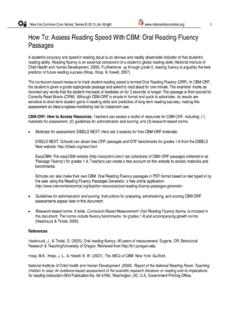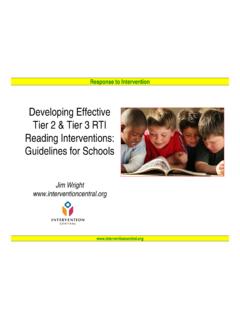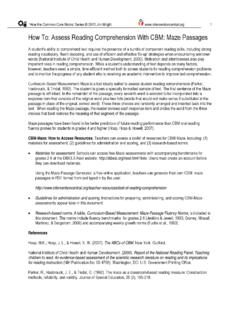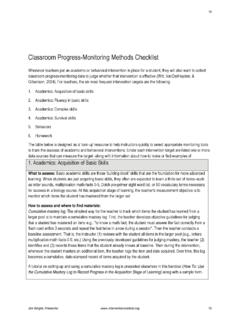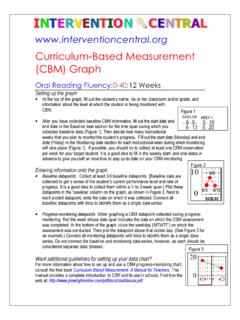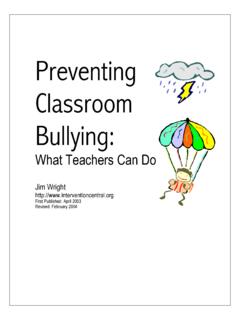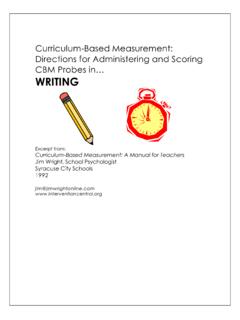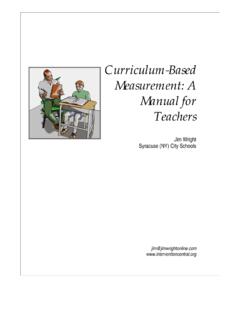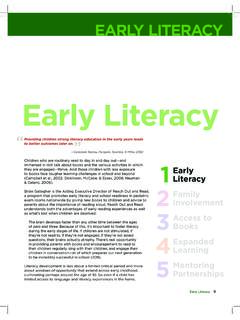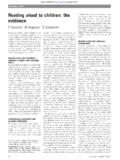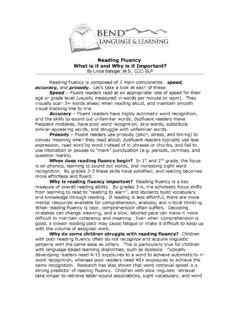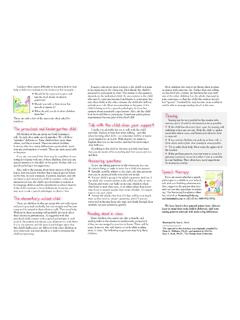Transcription of The Savvy Teacher’s Guide: Reading Interventions That Work
1 The Savvy Teacher's Guide: Reading Interventions That Work Jim Wright The Savvy Teacher's Guide: Reading Interventions That Work Jim Wright ( ) 2. Introduction I created the manual, The Savvy Teacher's Guide: Reading Interventions That Work, for classroom instructors who need to have a range of Reading Interventions available for students with diverse learning needs. The great majority of the Interventions described in this manual were selected because they had been cited as effective in the recent National Reading Panel (2000) report, a comprehensive meta-analysis of successful Reading strategies. All Interventions presented here are research-based. In most cases, I attempted to reconstruct the Reading strategy from the cited research articles with few if any changes. In some instances, however, I did make adaptations to the Interventions to make them more classroom-friendly.
2 Instructors who want to remain current on school-based Interventions being added to this manual series are encouraged to visit my website, Jim Wright July 2001. References: National Reading Panel. (2000). Teaching children to read: An evidence-based assessment of the scientific research literature on Reading and its implications for Reading instruction. (NIH Publication No. 00-4754). Washington, DC: National Institute of Child Health and Human Development. The Savvy Teacher's Guide: Reading Interventions That Work Jim Wright ( ) 3. The Savvy Teacher's Guide: Reading Interventions That Work --------------------------------------- Contents: 2. Introducing Academic Strategies to Students: A Direct-Instruction 4. Techniques to Promote Error 9. Word Supply ..10. Sentence Repeat ..10. Word Attack' Error Word Techniques to Promote Reading Fluency.
3 13. Assisted Reading Listening Passage Preview ..15. Paired Repeated Reading ..19. Techniques to Build Text Advanced Story Map Click or Clunk? A Student Comprehension Self-Check ..25. Keywords: A Memorization Main-Idea Mental Imagery: Improving Text Oral Recitation Prior Knowledge: Activating the Known' ..40. Reciprocal Teaching: A Reading Comprehension Text Lookback ..52. The Savvy Teacher's Guide: Reading Interventions That Work Jim Wright ( ) 4. Introducing Academic Strategies to Students: A Direct-Instruction Approach Teachers know how difficult it often is to get students to understand and use a new academic strategy. A number of roadblocks can prevent students from successfully applying strategies. For example, students may initially learn the steps of a strategy incorrectly and become discouraged when they discover that it does not help them with their work.
4 Even if students become proficient in using a strategy, they may fail to recognize those academic situations when the strategy should be applied. (An unused strategy is equal to no strategy at all!) Or students may know full well when they are supposed to use a strategy ( , proofreading a homework assignment) but simply be unmotivated to do so. Fortunately, you can follow a direct-instruction sequence to increase the probability that your students will both correctly master and actually use effective academic strategies. This framework includes four major stages: (1) you explicitly show students how to use the skill or strategy, (2) students practice the skill under your supervision--and you give frequent corrective feedback and praise, (3) students use the skill independently in real academic situations, and (4) students use the skill in a variety of other settings or situations ( generalization ).
5 To avoid overloading your students with more new information than they can absorb, teach only one strategy at a time and make sure that your students have thoroughly mastered each strategy before teaching them another. 1. Show them! : The teacher demonstrates to students how to use the skill. The goal in this introductory step is to demonstrate the strategy so clearly that students will have a firm understanding and foundation for their later mastery of the skill. In most cases, you should devote at least a full session to demonstrating the strategy. (More complex strategies may require additional time.) During the lesson, students should be actively engaged and responding, rather than passively listening. If possible, make the session fast-paced, interactive, and fun! Introduce the skill. To build a rationale for using the skill, discuss the problem or difficulty that it can resolve.
6 You might, for example, introduce the use of keywords (a strategy for memorizing factual information) by holding up a classroom science text and saying, You will need to remember hundreds of important facts from your The Savvy Teacher's Guide: Reading Interventions That Work Jim Wright ( ) 5. science Reading . Today we are going to learn a strategy that can help you to do this.. You can also stimulate student interest and motivation and activate the class's prior knowledge of the topic by having the group briefly share their own favorite techniques for accomplishing the same academic goal ( , What are some of your favorite ways to memorize lots of facts? ). Describe & demonstrate the skill. Present the main steps of the strategy in simple terms. List the same main steps on a wall poster or in a handout so that students can refer back to them as needed.
7 Use overhead transparencies or other visual aids to display examples of text, academic worksheets, or other materials that you will use to demonstrate the strategy. Consider handing out student copies of the same materials so that your class can work along with you. Take students through several demonstrations in which you walk through the steps of the strategy. Use a think-aloud procedure to share your reasoning with students as you apply the strategy. Start with simple examples that most students should be able to understand without difficulty. Introduce increasingly complex examples until you are demonstrating the strategy using grade-appropriate content. Elicit student participation. Run through several more demonstrations of the strategy, inviting student volunteers to come to the front of the room to walk the class through the strategy.
8 Or call on different students to share how they would apply each step. Give gentle, corrective feedback as needed. Praise students frequently and give them specific positive feedback whenever they correctly use a step in the strategy. Assess student understanding. The class is ready the move to the next stage of instruction when most students appear to have a general understanding of the steps in the strategy, and guidelines for when to use it. You should be able to tell through the quality of student responses whether the class grasps the strategy. 2. Watch them & praise them! : Students practice the skill under teacher supervision. At this stage, students have begun to acquire the strategy but need opportunities to practice it under teacher supervision. Teacher oversight and feedback is especially important to prevent students new to the skill from practicing it incorrectly.
9 Start by giving students simple examples. As students become more skilled in using the strategy, give them more advanced academic materials, until the examples are equal to grade-level work. For this stage, you may want to pair students and have them alternate roles: one student applies the strategy to an example, while the other acts as the observer who checks the posted strategy steps to be sure that all steps were correctly followed. As students work, you can walk around the room to monitor the dialog, The Savvy Teacher's Guide: Reading Interventions That Work Jim Wright ( ) 6. and provide feedback, praise, and assistance as needed. Alternatively, you may want to have students work independently and then report out' on their strategies to the larger group. Many students, particularly those who need more practice and support to learn a new skill, do best at this stage if they are encouraged initially to think aloud as they move through the strategy , stating each step of the skill as they implement it and giving reasons for the decisions that they make.
10 As students show that they can use the strategy dependably, you can fade' students' use of think aloud . First, demonstrate to them how lower their tone of voice during think-aloud until students are whispering softly the steps of the strategy. Then model to students how to mouth the steps silently or simply to think through the steps without actually stating them. While most of your students are likely to progress at a similar rate, you will probably find that several students are advanced in their understanding of the skill and others lag behind. You may want to assign advanced students as peer strategy coaches to work with their classmates. Students who struggle in acquiring the strategy may require scaffolding support (individual modifications to help them to master the concepts or tasks), such as additional teacher feedback and praise, simplified practice materials, or more opportunities to try out the skill.
